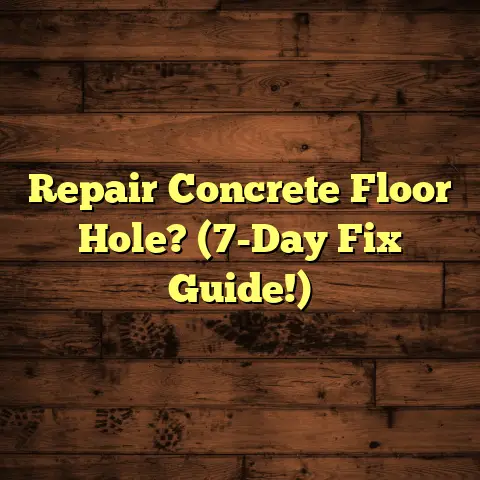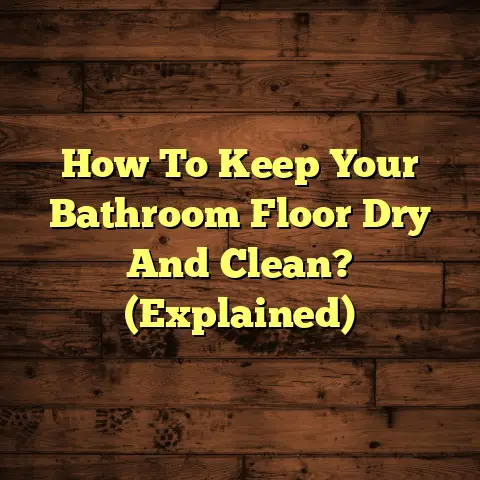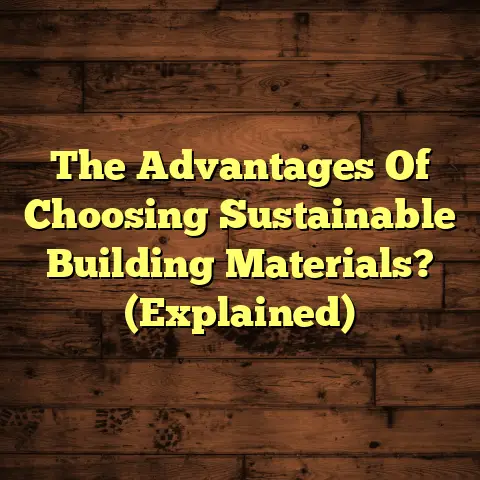Polished Concrete Look At Home: DIY Guide (7 Steps!)
(Image: A split image showing a dated, worn-out carpet on one side and a sleek, polished concrete floor on the other.)
I’ve seen trends come and go, but one that’s really stuck around – and for good reason – is polished concrete.It’s not just for industrial spaces anymore; polished concrete is popping up in homes everywhere, adding a modern, durable, and surprisingly stylish touch.
And guess what? You can totally achieve this look yourself! Think of the satisfaction of transforming your space with your own two hands.
This guide will walk you through the process, step-by-step, to get that gorgeous polished concrete look in your home. Let’s get started!
Section 1: Understanding Polished Concrete
So, what exactly is polished concrete? It’s not just slapping some shiny stuff on regular concrete.
It’s a multi-step process of grinding down the concrete surface, refining it with progressively finer grits, and then sealing it to create a smooth, durable, and reflective finish.
Think of it like sanding wood, but on a much larger scale and with diamond-infused tools!
Polished Concrete vs. Traditional Concrete Flooring
Traditional concrete floors are often left as-is, maybe painted or covered with epoxy.
They can be dusty, porous, and prone to staining. Polished concrete, on the other hand, is densified and sealed, making it much more resistant to wear and tear.
Benefits of Polished Concrete:
-
Sustainability: It utilizes the existing concrete slab, reducing the need for new materials.
-
Durability: Seriously tough stuff. It can withstand heavy foot traffic and resist damage.
-
Low Maintenance: Easy to clean and requires minimal upkeep.
-
Design Versatility: You can stain it, dye it, add aggregates, and choose your level of shine.
-
Cost-Effective: Long-term, it can be cheaper than other flooring options due to its longevity.
Finish Options:
-
Glossy: Reflective and modern, perfect for a contemporary look.
-
Satin: A softer sheen, offering a balance between shine and practicality.
-
Matte: A natural, understated look that’s great for rustic or minimalist styles.
-
Salt and Pepper: Exposes some of the aggregate for a unique, textured appearance.
The finish you choose really depends on your personal preference and the overall aesthetic you’re going for. I personally love the satin finish; it’s elegant without being too high-maintenance.
Section 2: Tools and Materials Needed
Alright, let’s talk about the gear you’ll need to get the job done. This is where you want to be prepared!
Essential Tools and Materials:
- Concrete Grinder/Polisher: This is your workhorse. You can rent these from most tool rental shops. Look for one with variable speed control.
- Rental Cost: Expect to pay around \$100-\$300 per day.
- Diamond Polishing Pads: These come in various grits, from coarse to fine. You’ll need a set.
- Grit Range: Typically 30/50, 100/200, 400, 800, 1500, 3000.
- Concrete Sealer: Protects the polished surface and enhances its shine. Choose a high-quality, penetrating sealer.
- Types: Acrylic, epoxy, polyurethane, lithium silicate.
- Safety Gear: Non-negotiable! Gloves, safety glasses, and a good quality dust mask or respirator are crucial.
- Vacuum Cleaner with HEPA Filter: You’ll be dealing with a lot of concrete dust.
- Mop and Bucket: For cleaning between steps and applying the sealer.
- Concrete Crack Filler (if needed): To repair any imperfections in the concrete.
- Spray Bottle: For applying water during the polishing process.
- Edge Grinder (optional): A smaller grinder for getting into corners and along edges.
Optional Materials:
- Concrete Stain or Dye: To add color and personality to your floor.
- Densifier: Hardens the concrete and makes it more resistant to abrasion.
- Concrete Hardener: Penetrates the concrete and chemically reacts to increase its surface hardness and density.
- Microfiber Pads: For applying the sealer and buffing the floor.
A Note on Safety: Concrete dust is not your friend. It can irritate your lungs and eyes. Always wear proper safety gear and ensure good ventilation. I can’t stress this enough!
Section 3: Preparing the Area
Preparation is key to a successful polished concrete project. Don’t skip this step!
- Clear the Area: Remove all furniture, rugs, and anything else that’s in the way. This includes removing baseboards for a cleaner finish along the walls.
- Clean the Concrete: Thoroughly clean the floor to remove any dirt, grease, adhesives, or coatings. A degreaser and a good scrubbing brush will do the trick.
- Repair Cracks and Imperfections: Use a concrete crack filler to repair any cracks or holes in the surface. Let it dry completely before moving on.
- Leveling (if needed): If your concrete floor is uneven, you may need to use a self-leveling compound to create a smooth surface for polishing.
Pro Tip: I usually do a test patch in an inconspicuous area to see how the concrete reacts to the grinding and polishing process. This can save you a lot of headaches later on.
Section 4: Grinding the Concrete
Now for the fun part – the grinding! This is where you’ll start to see the transformation happen.
- Initial Grind (Coarse Grit): Start with a coarse grit diamond polishing pad (e.g., 30/50 grit) to remove any imperfections and expose the aggregate.
- Operating the Grinder:
- Move in a consistent pattern: Overlap each pass by about 50% to ensure even grinding.
- Maintain consistent pressure: Don’t press down too hard, let the grinder do the work.
- Keep the grinder moving: Don’t let it sit in one spot, or you’ll create dips.
- Vacuuming: After each grinding step, thoroughly vacuum the floor to remove all dust and debris. This is crucial for achieving a smooth, even finish.
- Edge Grinding: Use an edge grinder to get into corners and along walls. This will ensure a consistent finish throughout the entire floor.
Important Considerations:
- Concrete Hardness: The hardness of your concrete will affect the speed of the grinding process. Softer concrete will grind faster than harder concrete.
- Dust Control: Grinding concrete creates a lot of dust. Use a vacuum attachment on your grinder to minimize dust and protect your lungs.
- Water (Wet Grinding): Some people prefer to grind concrete wet, which helps to reduce dust and keep the polishing pads cool. If you choose to grind wet, make sure you have a wet/dry vacuum to remove the slurry.
Section 5: Polishing the Concrete
Polishing is where you’ll bring out the shine and smoothness of your concrete floor. This is where patience pays off!
- Transitioning Grits: Gradually transition to finer grits of diamond polishing pads (e.g., 100/200, 400, 800, 1500, 3000). Each grit will refine the surface further, creating a smoother and more reflective finish.
- Polishing Technique:
- Use overlapping passes: Just like with grinding, overlap each pass by about 50%.
- Apply light pressure: Let the polisher do the work.
- Keep the pad clean: Clean the polishing pad regularly to remove any debris that could scratch the surface.
- Assessing the Finish: After each polishing step, inspect the floor to ensure that you’re achieving the desired level of shine and smoothness. If you’re not happy with the finish, go back and repeat the previous step.
Pro Tip: I like to use a spray bottle to mist the floor with water during the polishing process. This helps to keep the polishing pads cool and prevents them from clogging.
Section 6: Applying a Sealer
Sealing your polished concrete floor is essential to protect it from stains, spills, and wear and tear. It also enhances the shine and makes the floor easier to clean.
-
Types of Sealers:
- Acrylic Sealers: Affordable and easy to apply, but less durable than other options.
- Epoxy Sealers: Very durable and resistant to chemicals, but can be more difficult to apply.
- Polyurethane Sealers: Offer a good balance of durability and ease of application.
- Lithium Silicate Sealers (Densifiers): Penetrate the concrete and react chemically to harden and densify the surface.
-
Application:
- Clean the floor: Make sure the floor is clean and dry before applying the sealer.
- Apply the sealer: Use a microfiber pad or a sprayer to apply a thin, even coat of sealer.
- Allow to dry: Let the sealer dry completely according to the manufacturer’s instructions.
- Apply a second coat (optional): For extra protection, you can apply a second coat of sealer after the first coat has dried.
Drying and Curing:
- Drying Time: The drying time will vary depending on the type of sealer you use. Refer to the manufacturer’s instructions for specific drying times.
- Curing Time: The curing time is the amount of time it takes for the sealer to fully harden and reach its maximum strength. This can take several days or even weeks. Avoid heavy traffic on the floor during the curing period.
Section 7: Maintenance of Polished Concrete Floors
Taking care of your polished concrete floors is easy, but it’s important to follow a few simple guidelines to keep them looking their best.
- Cleaning:
- Sweep or vacuum regularly: To remove dust and debris.
- Mop with a neutral pH cleaner: Avoid using harsh chemicals or abrasive cleaners, as they can damage the sealer.
- Use a microfiber mop: For best results.
- Resealing:
- Frequency: Depending on the amount of traffic your floor receives, you may need to reseal it every 1-3 years.
- Signs it’s time to reseal: The floor starts to lose its shine, becomes more difficult to clean, or shows signs of staining.
- Addressing Scratches:
- Minor scratches: Can often be buffed out with a polishing pad.
- Deeper scratches: May require professional repair.
Recommended Products:
- Neutral pH cleaner: Look for cleaners specifically designed for polished concrete.
- Microfiber mops and pads: These are gentle on the surface and won’t scratch the floor.
A Note on Rugs: While polished concrete is durable, placing rugs in high-traffic areas can help to protect the floor from scratches and wear.
Conclusion
So, there you have it! Polishing concrete floors is a rewarding DIY project that can transform your home. It may seem daunting at first, but with the right tools, materials, and a little bit of patience, you can achieve professional-looking results.
The benefits are undeniable: a beautiful, durable, and low-maintenance floor that will last for years to come.
Don’t be afraid to get creative with stains, dyes, and decorative aggregates to create a unique and personalized look.
Embrace the process, and enjoy the satisfaction of creating a stunning polished concrete floor in your home!
Now, go forth and conquer that concrete! You’ve got this! And if you ever get stuck, don’t hesitate to reach out to a professional for help. We’re always here to lend a hand.





